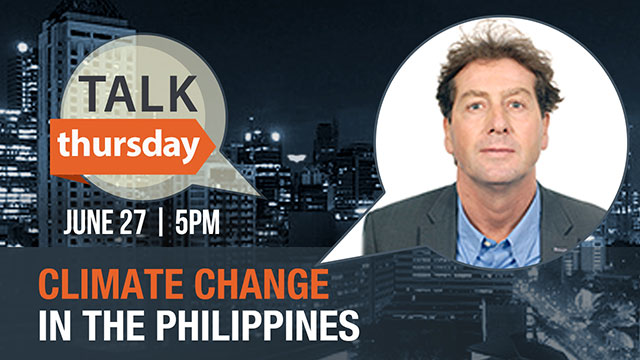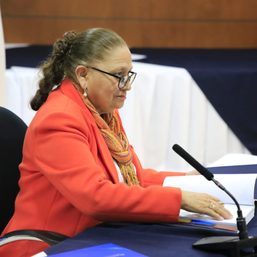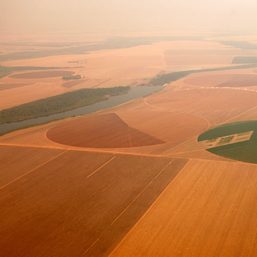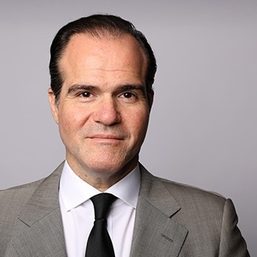SUMMARY
This is AI generated summarization, which may have errors. For context, always refer to the full article.

MANILA, Philippines – Rappler speaks with climate change expert, Christophe Crepin, sector leader for environment and climate change in the East Asia and Pacific region of the World Bank.
Crepin specialises in climate policy and climate finance. Working with the World Bank for over 15 years, Crepin led a number of environmental and climate policy dialogues, as well as advisory services in environmental management and climate change.
On Tuesday, the World Bank released a report on climate change in the country, naming the Philippines as the third most vulnerable country in the world to weather-related events and sea level rises.
The report projects greenhouse gas emissions in the Philippines will quadruple by 2030. Increased greenhouse gas emissions can reduce land for cultivation and accelerate reef degradation.
Discussing solutions, the World Bank report says measures can contribute to inclusive growth. Climate activities in agriculture and energy can create employment opportunities as well as build the resiliency of the country’s food and water supply.
Crepin will talk to Rappler about the climate change situation in the Philippines today, and what we can do about it.
Watch the interview live below.
It took you a year to do this report. What did you find?
CREPIN: We were asked by the government to look at the budget. How much is actually being spent on climate change and importantly, how the policies that have been put into place for years, which are focused on doing action on climate, how are these policies translating into budget and into action into result? And that’s what we’ve been focusing on.
Some people aren’t convinced there’s a problem with climate change. Is there a problem?
CREPIN: This is why there’s a chapter of the review that’s actually about climate science…The issue is we recognize the science is unequivocal. The planet is warming […] and this is translated into some physical impact in terms of sea level rise, in terms of intensification of storms, in terms of number and extended heat waves, important physical elements happening because of the changing climate.
I think even intuitively we’re starting to feel that, the storms last year, we’re going through different areas of the Philippines, can you take them apart one by one? The sea level rise, what does that mean exactly and what did you find in the Philippines?
CREPIN: It means that people who live on the coast and the PH is a country where quite a few people were living on the coast, many islands, it means also the poor of these people living on the coast in urban areas, they actually are likely exposed to that sea level rise. It means when you have a storm, the impact of that storm is worse because you’ve got some kind of combining effect, addition of risk and impact of different factors, so at the end of the day clearly the coast has become vulnerable and which is projected by science is it’s going to get worse as we move towards the end of this century.
Can climate change affect the path of storms?
CREPIN: Again, those are projections, indeed the past trajectory of storms seem to…have been or will be influenced by an evolving climate.
When you say the PH is vulnerable to rising sea levels, what does that mean for people? How will that impact the fishermen, the people on the coast lines?
CREPIN: One is the assets, whether they are on the committee level, the dark part of public good the government is financing in terms of bridges, those are going to be put at risk. Livelihood, people doing agriculture on the coast, people having some economic activity on the coast, tourism. All this will be under pressure.
The next thing you talked about are tropical cyclones, the storms themselves and the heat waves. How do those two things come together?
CREPIN: Those are stresses on the system, on the livelihood, on the people that add to each other. If you look at urban livelihood and where people are under difficult conditions, when there are heat waves it impacts people more than people in well-off, nice apartments with aircon.
What can be done now? From the study that you did?
CREPIN: What’s important for the PH to translate into action the framework … in terms of what can be done for climate change. One of the priorities of the government is to focus on adaptation, increasing the climate resilience of the economy, of people, of the society, of livelihood. And that’s priority no. 1. As you know climate change is two dimensional, one is reducing emission, greenhouse gases…
Filipinos say, well you know it’s not our fault, we’re not the ones spewing out greenhouse gas emissions. Normally it’s like a shifting of the blame, most of the time to the United States. Did you run into this while you were doing the study?
CREPIN: It’s clear that when you look at the sources of emission worldwide you basically focus on five, six major economies and that’s well known and I think people in the PH know it. What I think is important here is one, the country is engaged at the international level so that the dialogue takes place, there’s a discussion on how do we address that issue. That’s a global problem and that requires a global dialogue, some discussion among countries. The second is, as the economy develops, as the energy consumption increase, as transport becomes more carbon intensive, that the Filipinos contribute to lower (?) greener economy. And that is part of the government priority moving forward.
Do we emit enough? One of the results that you showed is we’re still in the top 25% in terms of developing nations in emitting greenhouse gas emissions. Is that something we need to worry about?
CREPIN: Looking forward is clearly part of the planning, vision, priorities of the government to promote some lower carbon greener technology consumption habits and overall development approaches.
How do you deal with issues like that because I’ve heard Filipinos say, why should it matter whether we cut our own emission if the Western world doesn’t cut their own emissions? How do you deal with issues like that in climate change when it’s really finger pointing, blaming each other?
CREPIN: There’s an intelligent framework for discussion to take place, UNFCC, the UN Convention to combat climate change. And so those discussion are taking place there and I think that’s the process and it’s going to continue and I think we’re making progress. It’s important for all of us and for an institution like the World Bank is to focus on what can be done. And what’s important here is, on what we should put the priority is 1. where it matters and where there is willingness to act, we are working with countries to lower emissions and do whatever is possible to act now and prepare for the future. The second thing we’re doing is…what can be avoided, what is going to happen that needs to be addressed? And that’s basically the second priority.
That seems to be connected…every year we have typhoon season, and that seems to be directly connected to disaster risk reduction. Is that connected to it or are you looking at it as two separate problems?
CREPIN: It’s one of the point we’re developing in the study which is that over the past few years, there has been a number of policy evolution, policy reform undertaken by the government and one of them is the shift on disaster risk management from a focus mainly on recovery to a focus also on risk prevention. And there is a lot of synergy and joint effort taking place in the context of adapting to climate change.
There’s a window of opportunity for Filipinos to actually do something, is that correct?
CREPIN: One of the message also that is not quite new but stressed here on the context of looking at the budget of this year, of next year, not the budget in 30 years. […] It’s important to act now. One, because some impact already felt now, and people see it and people ask for action now, and second is the number of decision in a country that grows at 6, 7, 8 percent per year, the number of decisions taken now that are going to impact the way the situation is going to…and therefore it’s important to act now.
From @MommyBolasiapao: Should the rich nations compensate the poor nations for messing up the planet?
CREPIN: That’s indeed a discussion that’s been going on for some time, that’s part of the global dialogue and how countries interact. I think that we’re getting closer to some common understanding as we move forward, there’s a framework for that to happen, the UNFCC, and I think that we need to make that process go. Meanwhile important to act when we can, where we can, and where there is willingness to make a difference.
What actions did you recommend in this report?
CREPIN: In this report, the focus has been on looking at the progress that have manifested these few years, on policy, institution and financing, how government works…and how much and how well the budget is aligned against the priority on climate change. So that we move from planning to execution and monitoring and reporting and that’s where the concept of accountability in terms of where action is being taken is being looked at.
So you’re really looking at what the government can do? How about the people themselves, is there anything they can do now, because they’re living through it?
CREPIN: Exactly, and so I think here there’s two aspects. One is we actually had the government to commission a survey that was done in March, April and that’s looking at one, the awareness, the understanding of the Filipino about climate change. And one of the questions was what are you doing about it? And clearly you see that there is a disconnect between perception of issues and what’s being done. And so that means that in terms of the awareness, in terms of dialogue, what we’re doing, this is important to continue. At the end of the day the solution is going to be what everyone contributing to this issue.
How do collaborative efforts from government and private sector address climate change?
CREPIN: There’s always the discussion that takes place in terms of how much government and the private sector work together. I think what it boils down to at the end of the day is one, whether there’s a common understanding of the problem. I think there was an opinion survey in the PH a few years ago, 79% of the business community here in the PH were actually concerned by climate change. First is common assessment of issue and creating the right condition for this to happen.
During the opinion survey that you talked about, what is your understanding of the common man? What is their understanding of climate change, did you get a sense of that?
CREPIN: High percentage of respondents said he has to be concerned about climate change.
79% of businesses concerned about climate change. We don’t see a lot of them on media. Even in terms of political debates and actions. Very few legislators talk about it yet so far. What other recommendations did you give them?
CREPIN: Adapting to climate change, if you look at the impact side of it, even moving to a lower carbon economy, greener economy is not going to happen overnight. There’s going to be a transformation process, 10, 15, 20, 30 years. That’s going to take time. What’s important is that there’s a demand for change. And so one of the recommendations of the report is government working with others to continue to support the understanding and the involvement of civil society in the discussion of climate chanfe so the demand for reform, for transformation is sustained.
You’re saying we have to get the information out to the public and then bring it back to the institutions to the people?
CREPIN: It’s for climate change, as for any transformation reform process is that if there’s no demand for it, that is not going to happen.
This type of political process takes a long time but climate change unfolds at a pretty rapid pace. Can you give me an idea of what it’ll look like in the PH in a decade? Should we be alarmed? If we don’t take action?
CREPIN: The World Bank issued a report last week on a 4 degree world, which is a scenario in terms of warming which is different from what has been discussed so far where the focus has been mostly on a 2 degree world. When we get back to the discussion earlier on in terms of sea level rise, in terms of intensification of storm, heat waves, acidification of the oceans in terms of coral reef…so those are 4, 5 key ticket items that are projected and assessed and discussed by the science.
It was talking about a generation though, you talked about the difference between a 2 degree world and 4 degree world. That 4 degree world, that difference of 2 degrees, what time table are you looking at if nothing is done?
CREPIN: What it means is if we are on the path for 4 degree world by the end of the century, it means that we would be at 2 degree in 20, 30 years. That means that in our lifetime, we would see some significant impact, things are going to accelerate. So that’s what we’re talking about.
In the PH, what would that look like?
CREPIN: Sea level rise, 30-50 cm of sea level rise.
Are we talking about some areas of the country underwater?
CREPIN: Manila is one of the most vulnerable and at risk…
Are we below the water?
CREPIN: Yes.
Last year in CDO we had a typhoon go through that area and there were parts of it engulfed in water.
CREPIN: Flood management is and will continue to be an important area to invest in and to focus on in terms of policy moving forward.
Your specific recommendations to the government aside from getting this out to the population and getting them to understand the problem, you’re talking about institutions that move very slowly.
CREPIN: I think the government has put in place some very solid policies in terms of objective and priorities therefore at this stage, the focus is how to get that implemented. It talks about prioritization, about getting common set of understanding of priorities within the government, priorities of climate change commission and department of agriculture. And from there, we use the budget as efficiently as possible to support these priorities but also to monitor the effectiveness of those actions.
These three things, policy, institution, financing, are we on the right track?
CREPIN: From policy assessment perspective, the reform have been done that in four years, actually moving in the right direction. Moving from a fragmented type of report to something comprehensive and coordinated, vertical dialogue on climate change. Now it’s about implementation.
What we’ve seen in last 2 years…from these typhoons we’ve had we’re reactive as a society…How long do we see before it becomes preventive? Will we get to a point where it becomes preventive?
CREPIN: That’s exactly a part of the dialogue that has to take place as we move forward. And all that energy spent when a disaster problem occurs transform into a willingness to act in terms of prevention, in terms of increasing climate resilience, the ability to adapt and prevent some of the consequences.
What are the biggest stumbling blocks to get there?
CREPIN: On the policy side, we need to get some clear alignment between the national level and sectoral level, local level, in terms of what needs to be done and where to put the priorities and it’s not quite there yet.
The local level in the end will be implementing.
CREPIN: Exactly. Then to reflect that in the budget process, to set in place the mechanism that allows to proactively allocate and budget on some of those priorities and be able to track what is being done and therefore what result these activity brings. And this is what … started to do in the context of this review, moving toward aligning the budget with the policy.
The policy level occurs at a much higher level than ordinary Filipinos. If they’re concerned about it, what can they do?
CREPIN: It’s important that the government at the various levels is supported, that the demand for action is expressed. It’s very important for any government in the world to get that support and backup from everyone, that this is a priority that needs to be done. And second is a matter of changing lifestyles, changing land use planning, development, adjusting different priorities. There are a number of things that can be done by ordinary Filipinos to adapt but also avoid making things worse.
What will make things worse?
CREPIN: One is, the PH is not a major emitter, but…
We were discussing the concept of locking, the decision taken now that are going to make things worse later. And I think this is one of the key elements to keep in mind. What is being done now, in terms of deforestation, where you develop your crops, they are going to contribute to increase in stresses on the system.
Everything you’ve mentioned still requires government initiative, laws that local govt can implement…you’ve talked about people pressuring government, but it’s also the government responsibility to educate people about this problem. It’s a chicken or egg question, where do you see movement happening now?
CREPIN: I think partnerships, everyone has to work on this. Movement is coming from different angles, I don’t think one is moving and the other one is not moving. Clearly the government has made a lot of progress in terms of changing policy, in terms of allocating more budget. Government is allocating more resources to activities that have a positive impact on climate related issues. The second is civil society is very active here so it’s coming from them. LGUs…some of LGUs actually not waiting for the government to issue a new law, they’re just doing it.
But I think we’ve learned our lessons because LGUs are at the forefront, when the typhoons hit. Is it enough?
CREPIN: It has to be part of the solution to some extent. We go back to discussion on whether there’s a demand and so when an LGU is confronted with that, it doesn’t wait for government to say this is important.
How strong is impact of CC on migration of people from disaster risk areas and what policy should the govt pursue?
CREPIN: A lot of discussion on climate change and migration. In the PH it’s important, there’s an urbanization process that’s going on, and where this urbanization is going to take place is going to be quite important in terms of the impact of tomorrow.
Are you seeing it now? Is there any direct impact?
CREPIN: It’s clear in a city where you’ve got some concentration of housing and especially a lot of poor in it, the impacts of disaster and sea level rise are quite meaningful compared to people in nice buildings.
This country is also fighting endemic corruption. What role is this playing in the fight vs climate change?
CREPIN: Whatever is being done with public institution and policies boils down to effectiveness of what’s being used. One of the core elements of this review is how do we make all this more effective? Whatever the reason is behind, the objective is to make that more effective, transparent, and increased accountability in terms of result.
-Rappler.com
Add a comment
How does this make you feel?


![[WATCH] Try This: Empanada Salteña from Argentina](https://www.rappler.com/tachyon/2023/04/try-this-empanada-saltena-argentina.jpg?resize=257%2C257&crop=765px%2C0px%2C1037px%2C1037px)


There are no comments yet. Add your comment to start the conversation.